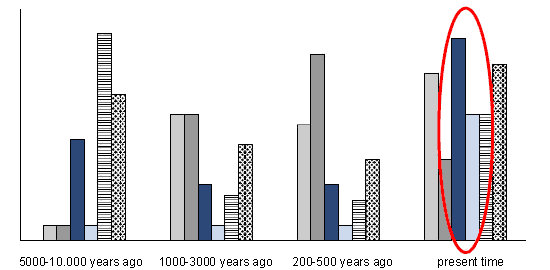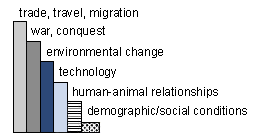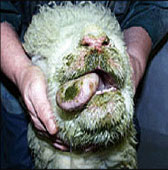Livestock diseases affected by climate change
Despite much of the talk and discussions surrounding climate change and diseases, there is limited evidence so far that climate has already favored disease (Lafferty 2009). Alternatively, changes in disease may have occurred but not yet been detected. As better information systems capable to measure change in disease patterns, vector distribution and environmental conditions are put in place, we may be surprised about the range of diseases directly or indirectly already affected by climate change.

| Indicative relative importance of various major environmental and social influences on infectious disease emergence, in each of the four major historical transitions. |
 |
 Among livestock diseases, experts agree that evidence exist for climate change to explain the recent spread of bluetongue virus observed in Europe since 1998 (Purse et al., 2005). Bluetongue is a devastating disease affecting ruminants caused by the bluetongue virus. This virus is transmitted predominantly through feeding of biting midges of the genus Culicoides. Although through the 20th century there were occasional incursions of bluetongue virus into Southern Europe, recent changes on bluetongue epidemiology indicate that this disease has spread throughout Europe. Several distinct strains have been detected since 1998 and the current distribution can be attributed to the recent and ongoing changes in climate. The spread of bluetongue virus is closely linked to the northern expansion of Culicoides imicola, the most important vector of bluetongue virus in Africa and Asia and it appears that the warming temperatures and changes in humidity across Europe have allowed its expansion and persistence during winter. The 1990s represented one of the warmest decades on record for Europe. Temperatures increased significantly resulting in warmer night-time temperatures and fewer frost days in the winter. The average annual precipitation and the number of wet days increased in the north but decreased in the south. Therefore there have been significant changes in climate that also have affected the drivers of bluetongue virus infection in Europe at the same times as the spread of bluetongue virus took place. In addition, these same climatic alterations have allowed indigenous European Culicoides spp to serve as competent bluetongue virus vectors thereby expanding the risk of transmission over larger geographical regions. The marked changes in bluetongue epidemiology in Europe do not seem to be caused by factors such as pathogen characteristics, host distribution or movements, or the circulation of new more virulent virus strains. Other factors such as land use, animal health systems or socio-economic changes also seem unlikely to be responsible for the changes in bluetongue epidemiology. Therefore, the changes in bluetongue incidence in Europe have been matched by spatio-temporal changes in regional climates, including the specific climatic drivers of bluetongue infection and have given a compelling argument for the role of climate change affecting bluetongue epidemiology (Purse et al., 2005). Overall this scenario offers practical indications that climate change is already substantially affecting the host-vector-pathogen dynamics of veterinary diseases.
Among livestock diseases, experts agree that evidence exist for climate change to explain the recent spread of bluetongue virus observed in Europe since 1998 (Purse et al., 2005). Bluetongue is a devastating disease affecting ruminants caused by the bluetongue virus. This virus is transmitted predominantly through feeding of biting midges of the genus Culicoides. Although through the 20th century there were occasional incursions of bluetongue virus into Southern Europe, recent changes on bluetongue epidemiology indicate that this disease has spread throughout Europe. Several distinct strains have been detected since 1998 and the current distribution can be attributed to the recent and ongoing changes in climate. The spread of bluetongue virus is closely linked to the northern expansion of Culicoides imicola, the most important vector of bluetongue virus in Africa and Asia and it appears that the warming temperatures and changes in humidity across Europe have allowed its expansion and persistence during winter. The 1990s represented one of the warmest decades on record for Europe. Temperatures increased significantly resulting in warmer night-time temperatures and fewer frost days in the winter. The average annual precipitation and the number of wet days increased in the north but decreased in the south. Therefore there have been significant changes in climate that also have affected the drivers of bluetongue virus infection in Europe at the same times as the spread of bluetongue virus took place. In addition, these same climatic alterations have allowed indigenous European Culicoides spp to serve as competent bluetongue virus vectors thereby expanding the risk of transmission over larger geographical regions. The marked changes in bluetongue epidemiology in Europe do not seem to be caused by factors such as pathogen characteristics, host distribution or movements, or the circulation of new more virulent virus strains. Other factors such as land use, animal health systems or socio-economic changes also seem unlikely to be responsible for the changes in bluetongue epidemiology. Therefore, the changes in bluetongue incidence in Europe have been matched by spatio-temporal changes in regional climates, including the specific climatic drivers of bluetongue infection and have given a compelling argument for the role of climate change affecting bluetongue epidemiology (Purse et al., 2005). Overall this scenario offers practical indications that climate change is already substantially affecting the host-vector-pathogen dynamics of veterinary diseases.
Another example of a disease that could be impacted by climate change is avian influenza (Gilbert et al., 2008). Although no direct link can be made yet on climate change and avian influenza, there are speculations on how climate change may affect the ecology of avian influenza viruses. Aquatic birds worldwide are the reservoir hosts for influenza A viruses. Climate change can alter bird migration patterns, changes in populations of waterfowl species (although it can be confounded by the natural habitat), influence avian influenza virus transmission cycle and the virus survival and persistence outside the host. Therefore, changes in the distribution and migratory patterns of the reservoirs for avian influenza can in turn affect the risk of exposure of these viruses to domestic poultry and humans.
Conclusions
Any infectious disease that directly or indirectly responds to environmental conditions may be affected by climate change. Vector borne diseases are especially susceptible to changing environmental conditions due to the impact of temperature, humidity and demographics of vectors. However, so far there is limited evidence that climate change is directly responsible for an increase in the incidence of livestock animal diseases with bluetongue disease in Europe being one of the exceptions. Climate change eliminates ecological barriers and constraints for pathogen transmission and timing of seasonal migration. Because information health systems are limited, changes in disease may have occurred but are not yet been detected. As better information systems are put in place capable of measuring change in disease patterns, vector distribution and environmental conditions, we may be surprised by the number of diseases directly or indirectly already affected by climate change.
However, exclusive focus on climate change alone will result in the neglect of social phenomena that may be more amenable to effective action aimed at reducing the incidence of disease. Other factors such as habitat alteration, presence of invasive species, agriculture, travel and migration, drug and pesticide resistance, malnutrition, urban heat, population density, health services, poverty and education maybe more relevant in affecting disease than climate per se. Often these factors are also directly or indirectly influenced by climate change and in many instances forcing the question what comes first the chicken or the egg? Nevertheless climate is changing and what we have learned with diseases over time, always expect the unexpected.




